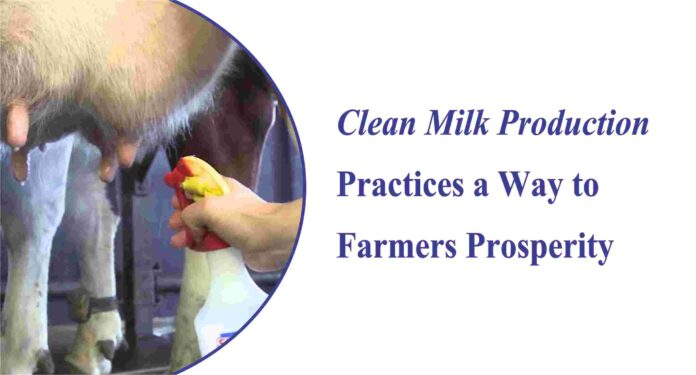Clean Milk Production: A Way to Healthy Milk Production
ABSTRACT
The clean milk production following Good hygienic practices is an essential prerequisite for obtaining wholesome and superior milk quality. The concept of unpolluted milk production would be to develop sustainable, scientific and eco-friendly dairy animal management supported the principles of unpolluted, green and ethical practices. Main sources of contamination are udder infection, dirty udders and teats, milking prson and milking equipements. Sick animals and their milk should not be mixed with good milk or milk from healthy animals. Udder, teats and flank of the animals are washed with clean water preferably with a disinfectant. Milkman should be healthy and clean. Seamless utensils preferably made of stainless steel should be used. Milking should be done through a full hand method to avoid any injuries on animal teats. All milk should be drained out from the udder i.e. incomplete milking should be avoided. proper care must be taken regarding the preservation of milk, protection of milk constituents, protection against high temperatures and natural calamity.
Key words: Milk, Udder, Utensil, Animal, Production
INTRODUCTION
“Clean Milk” is usually defined as “milk drawn from the udder of healthy animals, which is collected in clean, dry milking pails and free from extraneous matters like dust, dirt, flies, hay, manure, etc. Clean milk features a normal composition, possesses a natural milk flavor with low bacterial count and is safe for human consumption” (Sinha, 2000). The clean milk production following Good hygienic practices is an essential prerequisite for obtaining wholesome and superior milk quality. The concept of unpolluted milk production would be to develop sustainable, scientific and eco-friendly dairy animal management supported the principles of unpolluted, green and ethical practices. Normal whole milk contains a balanced proportion of milk fat (4 percent), lactose (4.8 percent), proteins (3.5 percent), minerals (0.7 percent), vitamins and other minor constituents such as enzymes and hormones. The pH of normal raw milk is about neutral (pH 6.7) with a corresponding titratable acidity of 0.16-0.17 percent due to the natural buffering capacity of milk proteins and salts. Wholesome milk should contain only a few bacteria and no extraneous matter if it has been produced hygienically.
The following are the pre-requisite for clean milk production and disposal.
Hygiene and Precautions
With a strip cup or any other method case of mastitis is checked. Sick animals and their milk should not be mixed with good milk or milk from healthy animals. Udder, teats and flank of the animals are washed with clean water preferably with a disinfectant. After that, the body parts wipe with a clean cloth. Brooming and cutting the hair around the udder is necessary. Disposal of fore-milk and tying the tail of troublesome animals when milking is required.
Milkman’s Hygiene
Milkman should be healthy and clean. Maintenance short fingernails and haircutting is required and ladies can cover their heads while milking as a precaution. Smoking during milking time should be avoided. Interruptions during milking should be avoided.
Milking Environment
The animal sheds should be cleaned regularly. Water should drain easily and far away from the shed. Providing animals, clean feed and water trough are essential. The shed should be located away from bad smells and odors.
Milking Utensils
Seamless utensils preferably made of stainless steel should be used. Cleaning utensils with a brush and hot water mixed with detergent is one of the major requirements for production of clean milk. After cleaning utensils, it should be kept in sunlight for proper drying.
Milking
For milking, squeezing the teat is required. Milking should be done through a full hand method to avoid any injuries on animal teats. All milk should be drained out from the udder i.e. incomplete milking should be avoided. Using a teat dip after milking is a good practice for the production of clean milk.
Milk Handling
- Filtering After milking, milk should be filtered through the sieve for removing suspended matter.
- Storage Milk should be stored in a cool and clean place and the room used to store milk should be without other materials such as chemicals.
- Marketing or Disposal of Clean Milk Milk should be delivered to the market as soon as possible. Closed mouthed cans should be used for transportation purposes. It is advisable to deliver milk early in the morning and evening to avoid hot periods of the day.
Benefits of clean milk production
1. It is safe for human consumption
2. It has better keeping quality
3. It has high commercial value
4. It provides protection against diseases like typhoid, dysentery, diphtheria, septic sore throat, etc.
5. It helps to produce good quality dairy products
6. It can be transported over long distances
CONCLUSION
Milk once secreted becomes the target for transformation by a spread of host organisms at the farm itself. Hence, proper care must be taken regarding the preservation of milk, protection of milk constituents, protection against high temperatures and natural calamity. Strict protocols are to be observed and implemented both in hand and machine milking. The custodian of milk should never compromise on quality.
Compiled & Shared by- This paper is a compilation of groupwork provided by the
Team, LITD (Livestock Institute of Training & Development)
Image-Courtesy-Google
Reference-On Request.



